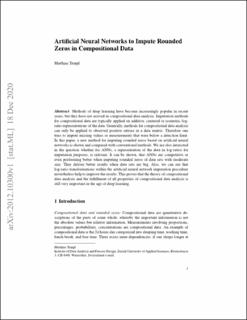Please use this identifier to cite or link to this item:
https://doi.org/10.21256/zhaw-21964Full metadata record
| DC Field | Value | Language |
|---|---|---|
| dc.contributor.author | Templ, Matthias | - |
| dc.date.accessioned | 2021-03-12T13:13:16Z | - |
| dc.date.available | 2021-03-12T13:13:16Z | - |
| dc.date.issued | 2020-12-18 | - |
| dc.identifier.other | arXiv:2012.10300v1 | de_CH |
| dc.identifier.uri | https://arxiv.org/abs/2012.10300 | de_CH |
| dc.identifier.uri | https://digitalcollection.zhaw.ch/handle/11475/21964 | - |
| dc.description.abstract | Methods of deep learning have become increasingly popular in recent years, but they have not arrived in compositional data analysis. Imputation methods for compositional data are typically applied on additive, centered or isometric log-ratio representations of the data. Generally, methods for compositional data analysis can only be applied to observed positive entries in a data matrix. Therefore one tries to impute missing values or measurements that were below a detection limit. In this paper, a new method for imputing rounded zeros based on artificial neural networks is shown and compared with conventional methods. We are also interested in the question whether for ANNs, a representation of the data in log-ratios for imputation purposes, is relevant. It can be shown, that ANNs are competitive or even performing better when imputing rounded zeros of data sets with moderate size. They deliver better results when data sets are big. Also, we can see that log-ratio transformations within the artificial neural network imputation procedure nevertheless help to improve the results. This proves that the theory of compositional data analysis and the fulfillment of all properties of compositional data analysis is still very important in the age of deep learning. | de_CH |
| dc.format.extent | 26 | de_CH |
| dc.language.iso | en | de_CH |
| dc.publisher | arXiv | de_CH |
| dc.rights | http://creativecommons.org/licenses/by-nc-nd/4.0/ | de_CH |
| dc.subject | Deep learning | de_CH |
| dc.subject | Artificial neural networks | de_CH |
| dc.subject | Compositional data | de_CH |
| dc.subject | Rounded zeros | de_CH |
| dc.subject | Imputation | de_CH |
| dc.subject | Replacement | de_CH |
| dc.subject.ddc | 006: Spezielle Computerverfahren | de_CH |
| dc.title | Artificial neural networks to impute rounded zeros in compositional data | de_CH |
| dc.type | Working Paper – Gutachten – Studie | de_CH |
| dcterms.type | Text | de_CH |
| zhaw.departement | School of Engineering | de_CH |
| zhaw.organisationalunit | Institut für Datenanalyse und Prozessdesign (IDP) | de_CH |
| dc.identifier.doi | 10.21256/zhaw-21964 | - |
| zhaw.funding.eu | No | de_CH |
| zhaw.originated.zhaw | Yes | de_CH |
| zhaw.webfeed | Statistik und Quantitative Finance | de_CH |
| zhaw.author.additional | No | de_CH |
| zhaw.display.portrait | Yes | de_CH |
| Appears in collections: | Publikationen School of Engineering | |
Files in This Item:
| File | Description | Size | Format | |
|---|---|---|---|---|
| 2020_Templ_Artificial-neural-networks-to-impute-rounded-zeros-in-compositional-data.pdf | 581.04 kB | Adobe PDF |  View/Open |
Show simple item record
Templ, M. (2020). Artificial neural networks to impute rounded zeros in compositional data. arXiv. https://doi.org/10.21256/zhaw-21964
Templ, M. (2020) Artificial neural networks to impute rounded zeros in compositional data. arXiv. Available at: https://doi.org/10.21256/zhaw-21964.
M. Templ, “Artificial neural networks to impute rounded zeros in compositional data,” arXiv, Dec. 2020. doi: 10.21256/zhaw-21964.
TEMPL, Matthias, 2020. Artificial neural networks to impute rounded zeros in compositional data [online]. arXiv. Verfügbar unter: https://arxiv.org/abs/2012.10300
Templ, Matthias. 2020. “Artificial Neural Networks to Impute Rounded Zeros in Compositional Data.” arXiv. https://doi.org/10.21256/zhaw-21964.
Templ, Matthias. Artificial Neural Networks to Impute Rounded Zeros in Compositional Data. arXiv, 18 Dec. 2020, https://doi.org/10.21256/zhaw-21964.
Items in DSpace are protected by copyright, with all rights reserved, unless otherwise indicated.